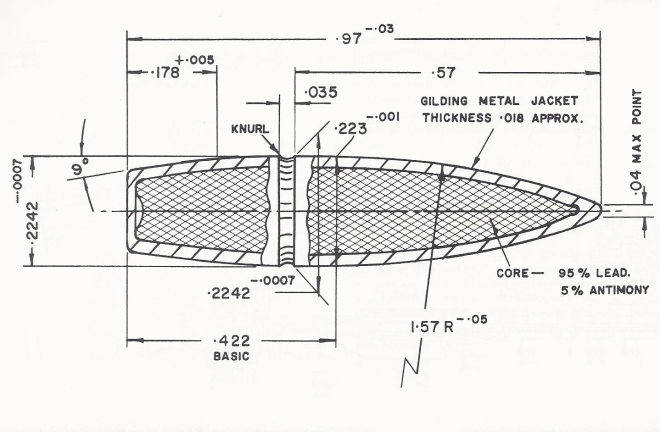This week’s document, An Investigation of An Experimental Caliber .22 High Velocity Bullet For Rifles, is the report created from one of the first serious investigations of small caliber high velocity ammunition for the standard infantry weapon. Its author, William C. Davis, is one of the key figures in the history of the military .22, with a career in ballistics spanning over half a century.
An Investigation covers the earliest Project SALVO experiments utilizing a necked down 7.62mm NATO case firing a scaled down homologue of the excellent boattailed .30 caliber US M1 Ball round, weighing 68grs. The test article fired this bullet at approximately 3,400 ft/s, and was tested directly against the then-current .30-06 service round. The results were, and still are, surprising:
The ammunition employing the experimental caliber. 22 HV rifle bullet was superior to caliber .30 M2 ball with respect to impact velocities, flatness of trajectory, deflection by cross-wind, perforation of armor plate, perforation of helmets, penetration of pine boards at 2,000 yards, lightness of recoil, and lightness of weight. With respect to over-all wound-ballistic performance, it was approximately equal to caliber .30 bullets with which it was compared.
…
It is recommended that using forces be invited to comment on results of the testing described here.
Contingent upon the using forces’ expression of further interest, it is recommended that additional weapons and ammunition be procured for further engineering development and for such evaluation as using forces may desire to make at that time.
The result of further investigation showed that, given the results of the Hitchman reports, the .22 High Velocity was “too much” cartridge, but that the .22 Gustafson, with its light 41gr bullet and 3,000 ft/s muzzle velocity, was “too little” to meet contemporary requirements. A bullet weight of 55 grains – the average of the 41gr and 68 gr bullets thus far tested – was decided upon, and the then-new commercial .222 Remington cartridge was considered an ideal test platform. Eventually, the M193 rifle cartridge would be adopted, sporting performance almost exactly in between that of the .22 HV and .22 Gustafson in both bullet weight and velocity.
 Your Privacy Choices
Your Privacy Choices
